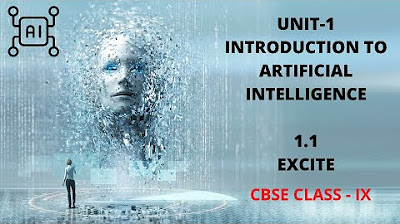IMT - AI (1) - Apa itu AI?, Sejarah, dan Penerapan AI
Summary
TLDRThis video script introduces the concept of Artificial Intelligence (AI), its history, and applications. It explains AI as a field of computer science aimed at creating intelligence in machines capable of solving problems and replicating human thinking. The script covers AI capabilities like natural language processing, knowledge representation, automated reasoning, machine learning, computer vision, and robotics. It also discusses the idea of an intelligence agent, rationality, and the importance of evaluating an agent's performance based on its environment. The script uses examples like smart sprinklers and vacuum robots to illustrate the practical application of AI.
Takeaways
- 😀 Artificial Intelligence (AI) is designed to mimic human thinking processes to solve problems.
- 🔍 AI encompasses various capabilities such as natural language processing, knowledge representation, automated reasoning, machine learning, and computer vision.
- 📚 The concept of AI is rooted in human intelligence, aiming to replicate our thought processes in machines.
- 🌐 AI can be applied in numerous fields, including smartphones, self-driving cars, and robotics.
- 🤖 An Intelligence Agent is a computer entity that perceives its environment and acts based on that perception.
- 💧 Sprinkle A, which turns on based on weather conditions, is an example of an intelligent agent, unlike Sprinkle B which operates on a fixed schedule.
- 🧹 The vacuum robot is a clear example of an intelligent agent, capable of detecting dirt and taking appropriate actions.
- 📏 Rationality in AI is defined by an agent's ability to perform the right actions based on its environment and programmed functions.
- 🌐 The environment for AI can be characterized by its observability, the number of agents involved, determinism, and the nature of the steps that can be taken.
- 🔄 AI environments can be static or dynamic, with dynamic environments changing while the agent is making decisions.
Q & A
What is the main topic of the session presented by Evantanwijaya?
-The main topic of the session is explaining what artificial intelligence (AI) is, its history, and its applications.
What are the learning outcomes expected for students in this session?
-Students are expected to understand the definition of AI, the concept of intelligent agents, how to determine the right AI system for various tasks and needs, and the structure of agent programs.
How is artificial intelligence defined in the script?
-Artificial intelligence is defined as a field in computer science that aims to create intelligence on computers capable of solving problems, mimicking human thinking and problem-solving.
What are the capabilities of artificial intelligence mentioned in the script?
-The capabilities include natural language processing, knowledge representation, automated reasoning, machine learning, computer vision, and robotics.
Who is credited with coining the term 'artificial intelligence' and when did this happen?
-Alan Turing is credited with coining the term 'artificial intelligence' in 1947 during a lecture in London.
What is an intelligence agent as described in the script?
-An intelligence agent is a computer object that can perceive the environment through sensors and act based on the environment's state using actuators.
What is the difference between Sprinkle A and Sprinkle B in the example provided?
-Sprinkle A is considered an agent because it processes environmental input and turns on when needed based on weather conditions, while Sprinkle B operates on a fixed schedule and is not considered an agent.
What is meant by 'rationality' in the context of AI agents?
-Rationality in AI agents refers to an agent performing the right actions for each entry in the agent's function table, producing a series of actions based on the environment's state.
How can the task environment for an AI agent be defined?
-The task environment can be defined by specifying the problem, the processes involved in the task environment, and the properties of the task environment itself.
What are the properties of the task environment discussed in the script?
-The properties discussed include observability (fully, partially, or unobservable), the number of agents (single or multiple), determinism (deterministic, stochastic, or non-deterministic), and the nature of the environment (static or dynamic).
How is the performance of a vacuum robot measured according to the script?
-The performance of a vacuum robot is measured by how clean the floor it cleans, the type of surface (rough or smooth), and the effectiveness of its actuators and sensors.
Outlines

Cette section est réservée aux utilisateurs payants. Améliorez votre compte pour accéder à cette section.
Améliorer maintenantMindmap

Cette section est réservée aux utilisateurs payants. Améliorez votre compte pour accéder à cette section.
Améliorer maintenantKeywords

Cette section est réservée aux utilisateurs payants. Améliorez votre compte pour accéder à cette section.
Améliorer maintenantHighlights

Cette section est réservée aux utilisateurs payants. Améliorez votre compte pour accéder à cette section.
Améliorer maintenantTranscripts

Cette section est réservée aux utilisateurs payants. Améliorez votre compte pour accéder à cette section.
Améliorer maintenantVoir Plus de Vidéos Connexes

What Is Artificial Intelligence? | Artificial Intelligence (AI) In 10 Minutes | Edureka

Fundamentos de Sistemas Inteligentes - Aula 1 - Introdução a Inteligência Artificial

UNIT-1 INTRODUCTION TO AI SUB-UNIT - 1.1- EXCITE CLASS 8-9 CBSE (AI-417)

L7 02 Definisi Planning

DL.1.1. Fundamentals of Deep Learning Part 1

U7-01 V2 Lektionsübersicht V2
5.0 / 5 (0 votes)
